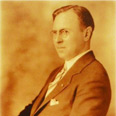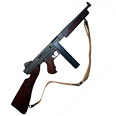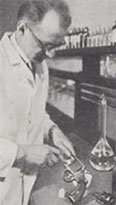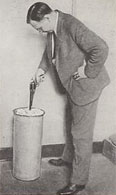Home | Glossary | Resources | Help | Contact Us | Course Map
Archival Notice
This is an archive page that is no longer being updated. It may contain outdated information and links may no longer function as originally intended.
1921-1924
1921
A court in Oregon allowed a sheriff to provide expert testimony involving the linkage of a fired cartridge case to the evidence rifle. The sheriff was able to explain and demonstrate to the court how a small flaw in the breechblock of the rifle left an identifiable mark on the rim of the ejected cartridge case that had been fired in the rifle.
1922
A. J. Eddy, practicing attorney and researcher in the area of bullet identification, testified in the Arizona case of murder suspect Paul V. Hadley. Eddy conducted numerous tests on the suspect murder weapon as well as other .32 caliber firearms. The Mauser pistol was test fired, using ammunition seized from Hadley; the test and fatal bullets were photographed. Eddy testified in court to his findings, concluding that each pistol left its own distinctive characteristic markings on bullets.
It was argued in court that Eddy did not qualify as an expert witness. However, the judge allowed Eddys testimony as being that of a semi-expert. Due in large part to Eddys testimony, Hadley was convicted. The case was appealed to the Arizona Supreme Court, which upheld the lower court. This ruling represented the first time that a state supreme court recognized firearms identification evidence as being valid and admissible.
1923
The Frye opinion, issued in Frye v. United States , significantly impacted the acceptance of expert testimony. Known as the general acceptance test, the Frye court explained:
Just when a scientific principle or discovery crosses the line between the experimental and demonstrable stages is difficult to define... [W]hile courts will go a long way in admitting expert testimony deduced from a well-recognized scientific principle or discovery, the thing from which the deduction is made must be sufficiently established to have gained general acceptance in the particular field in which it belongs.
1923
The number of court cases involving firearms testimony increased:
- In an Oregon case, the judge allowed a pistol expert to testify that the evidence bullets were fired in a Colt Army Special revolver similar to the firearm owned by the defendant.
- A Washington, D.C. court decided that expert testimony provided concerning the evidence bullet as having been fired from the defendants pistol was competent.
- A Connecticut state court case, State v. Harold Israel , resulted in the prosecuting attorney recommending that the charge of murder be dismissed. His recommendation was based, in part, on the opinion of six expert witnesses that the fatal murder bullet could not have been fired from the defendants pistol.
- Dr. J. Howard Mathews, the Chairman of the Department of Chemistry at the University of Wisconsin, was requested to examine a rifle used in a Wisconsin homicide case. As a result of this case, followed by others, he became involved in the examination and identification of firearms-related evidence.
1924
Dr. Sydney Smith examined firearms evidence related to the murder of the Sirdar (commander-in-chief) of the Egyptian army and governor-general of the Sudan, his driver, and aide-de-camp. The victims were shot and killed while driving through the streets of Cairo, Egypt. Dr. Smith reconstructed the crime scene and examined the car and firearms evidence.
Eight suspects were charged with murder or incitement to murder and tried in court. Dr. Smiths examination, in conjunction with the items from the crime scene and autopsies, allowed him to identify the firearms used during the shooting. His testimony played a crucial role in the conviction of the suspects.
Dr. Smith wrote an article concerning the details of the investigation that appeared in the British Medical Journal in January 1926.
1925-1929
1925
Charles E. Waite, Calvin H. Goddard, Philip O. Gravelle, and John H. Fisher established the Bureau of Forensic Ballistics in New York City. The Bureau was formed to provide firearms identification services throughout the United States. After Waite died in 1926, Goddard headed the bureau until it disbanded in 1929.
Gravelle and Goddard applied comparison microscopy to the field of firearms identification. This allowed the examiner to more readily identify matching striae.
Goddard and Fisher developed the helixometer, a magnifier probe used to examine the interior of firearm barrels and accurately measure the pitch of rifling. Limited application led to its obsolescence.
In June 1925, the Saturday Evening Post published a two-part series of articles entitled Fingerprinting Bullets The Silent Witness. These articles were instrumental in informing the public about both the science of firearm identification and the availability of services offered by the Bureau of Forensic Ballistics.
1926
Captain Edward C. Ned Crossman, a well-known shooter and sports writer, examined firearms evidence for the Los Angeles County sheriff. He became associated with the Bureau of Forensic Ballistics, serving as a regional representative for the western portion of the United States.
1927
A special committee was appointed to review the findings of the Sacco and Vanzetti case. Colonel Calvin Goddard used the comparison microscope and helixometer (recent technological advancements previously unavailable) to reexamine recovered evidence bullets and cartridge cases. He was able to verify that one fatal bullet and one cartridge case had been fired from Saccos pistol. These findings were verified by subsequent reexaminations in 1961 and 1983.
1929
Intense public interest surrounding the St. Valentines Day Massacre (February 14, 1929, Chicago, Illinois), coupled with rumors that police officers may have been involved, prompted local officials to impanel a grand jury to investigate the slaying of seven gangsters by a rival gangster group.
The grand jury foreman engaged the services of Calvin H. Goddard of the Bureau of Forensic Ballistics to examine firearms-related evidence, which included fired bullets, pellets, fired shotshell cases, and fired cartridge cases. Goddard concluded that the killers had used one 12-gauge shotgun and two Thompson submachine guns. He noted that one of the Thompson submachine guns was fired using a fifty-round drum magazine while the other was fired using a twenty-round magazine.
Goddard tested all police Thompson submachine guns, comparing them to the crime scene evidence. He determined that none of the police weapons were used in the killings; he subsequently identified firearms obtained during the search of a suspects home as the murder weapons.
1930-1939
1930
The foreman of the St. Valentines Day Massacre grand jury established the Scientific Crime Detection Laboratory (SCDL) through private funding. Calvin Goddard became director of the laboratory, which was affiliated with the Northwestern University School of Law near Chicago. He remained director until 1934, when he formed a private firm. During his directorship, Goddard provided scientific training in the areas of firearm and toolmark identification to numerous individuals who went on to work in other laboratories around the United States.
1932
The Federal Bureau of Investigation (FBI) laboratory was established at the direction of then Director J. Edgar Hoover. It is noteworthy that the first person to staff the FBI laboratory received training from Calvin Goddard at the SCDL.
1934
Major Sir Gerald Burrard wrote a book titled The Identification of Firearms and Forensic Ballistics, which was published in London, England. In his book, Burrard discusses many of the early cases that occurred in the British Empire. Burrard acknowledges Colonel H. W. Todhunter, C.M.G. (former chief inspector of small arms for the British Army) as the pioneer of firearms identification in the United Kingdom.
1935
Julian S. Hatcher, an experienced U.S. Army ordnance officer, wrote Textbook of Firearms Investigation, Identification and Evidence , one of two significant books from this period. Major Hatcher served in a variety of assignments involving the design, manufacture, and testing of ammunition and firearms. This book was adopted by many firearm examiners throughout the United States and contained several photographs provided by Captain Ned Crossman.
Jack D. Gunther, a New York attorney and Professor Charles O. Gunther, a professor of mathematics and a reserve Lieutenant Colonel in the U.S. Army Ordnance Department, co-authored another important text entitled The Identification of Firearms . Their book provided additional information about the principles of firearms identification including details of the Sacco-Vanzetti case. The Gunthers reinforced the need for scientific methodology in the field of firearms identification.
1938
Originally a private laboratory under the direction of Calvin Goddard, the Scientific Crime Detection Laboratory at Northwestern University (SCDL) was bought by the City of Chicago. The equipment was transferred from the University to the Chicago Police Department and existing laboratory personnel were offered positions in the new laboratory.
1940-1950
1940-1947
A number of state and municipal crime laboratories were established across the United States, with forensic disciplines that included firearm and toolmark examination.
Laboratories established during this time included
- the first criminology laboratory established in Oakland, California,
- the Indianapolis Police Department (IPD), a fully equipped crime laboratory under the direction of a trained scientist,
- the first state crime laboratory in Wisconsin, supervised by Charles M. Wilson, who was associated with Goddard at the SCDL at Northwestern and who later became the director of the Chicago Police Department Crime Laboratory.
1948
The First American Medicolegal Congress meeting was held in St. Louis, Missouri.
Two papers were presented at the initial meeting concerning firearms identification:
- "Firearms Evidence Fact and Fiction," presented by George W. Keenan, Department of Public Safety, Rochester, New York
- "The Recovery, Custody, Marking, and Preservation of Physical Evidence and Standards of Comparison Including Firearms Exhibits," presented by Charles M. Wilson, of the Wisconsin State Crime Laboratory, Madison, Wisconsin
1949
Colonel Calvin H. Goddard became the commanding officer of the U.S. Army Criminal Investigation Laboratory Far East (Tokyo, Japan). He was instrumental in training examiners within the U.S. Army Laboratory System until his retirement from the service.
1950
In response to interest generated during the 1948 First American Medicolegal Congress meeting, the American Academy of Forensic Sciences (AAFS) was formally established and began publication of the Journal of Forensic Science (JFS).
Additional Online Courses
- What Every First Responding Officer Should Know About DNA Evidence
- Collecting DNA Evidence at Property Crime Scenes
- DNA – A Prosecutor’s Practice Notebook
- Crime Scene and DNA Basics
- Laboratory Safety Programs
- DNA Amplification
- Population Genetics and Statistics
- Non-STR DNA Markers: SNPs, Y-STRs, LCN and mtDNA
- Firearms Examiner Training
- Forensic DNA Education for Law Enforcement Decisionmakers
- What Every Investigator and Evidence Technician Should Know About DNA Evidence
- Principles of Forensic DNA for Officers of the Court
- Law 101: Legal Guide for the Forensic Expert
- Laboratory Orientation and Testing of Body Fluids and Tissues
- DNA Extraction and Quantitation
- STR Data Analysis and Interpretation
- Communication Skills, Report Writing, and Courtroom Testimony
- Español for Law Enforcement
- Amplified DNA Product Separation for Forensic Analysts












